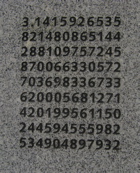
I was in the Washington Park MAX Station in Portland yesterday, which includes a core sample taken during the tunnel’s construction along with a 16-million-year timeline showing when each sample had been at the Earth’s surface. Etched into the wall along the timeline include technical and mathematical discoveries, including 107 digits of pi. Only, I noticed as I read through the digits, it’s wrong. The first row is correct, but the rest looks random. My friend and I speculated on our ride back why that might be. Was it an estimate, the result of calculating only the first several terms of an infinite series? A deliberate retelling of an historically significant blunder? A secret code left by the artist that translates to “help, I’m being held captive in a Portland artist colony!”?
Google to the rescue, it turns out this was either a clever way of representing the first 1000 digits of pi, or more likely was a simple misreading of the reference book from which the number came. As Mark Cowan points out in Underground Pi, the numbers etched in stone in the subway were taken from A History of Pi, which prints the digits in rows of 10 groups of 10 digits. The artist clearly took his numbers from the first column in that reference, thus printing the first thru tenth fractional digits, the 101th-110th, etc.